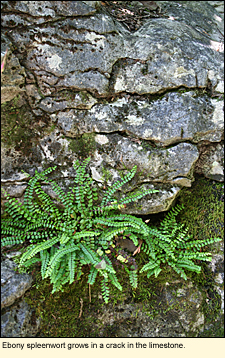Home > Recreation > State ParksClark Reservation State Park6105 E. Seneca Tnpk. Jamesville, NY 13078 315-492-1590 Services: J,K,M,O,P,Q,R,U,CC
LocationClark Reservation is located 5 mi./8 km. southeast of the City of Syracuse in the Town of DeWitt in Onondaga County. Geological HistoryThe outstanding feature of the park is a limestone escarpment created 400 million years ago when much of the continent was covered by a salt sea. From this escarpment one can stand and look down into a circular lake below. It is thought that, when the glaciers receded thousands of years ago, an enormous waterfall tumbled over the escarpment into a plunge basin. Over the millennia, the water stopped flowing. What remained is called Green Lake, one of the finest examples of a glacial cataract lake in eastern North America.
Natural HistoryDue in part to the limestone escarpment, Clark Reservation is botanically rich with more than 300 species of plants. One of the Park HistoryIndians were familiar with the area and are believed to have visited the lake regularly. In 1878, James McFarlane of Pennsylvania developed the area into a resort with a small hotel, trails, and a boat ride on the lake.
The resort failed, and the area became a public park. Wanting to preserve the park's unique geological and botanical history, Mary Clark Thompson, wife of banker Frederick Ferris Thompson, purchased the 108 acres surrounding the 10-acre meromictic lake in 1915. (At the time, Mrs. Thompson and her husband already owned Sonnenberg, which later became Sonnenberg Gardens & Mansion State Historic Park.) She donated the land to the state as a memorial to her father, Myron Clark, who had been governor of the State of New York from 1855 to 1857. Clark Reservation became a state Park in 1926. FacilitiesMost of the facilities are at the top of the escarpment. Here you will find parking, bathrooms, a nature center, a native plant garden, a playground, ball fields, a picnic area, two reservable picnic pavilions (one of which overlooks the lake), and access to most of the trails.
Visitors should stop in at the nature center first to look at fossils, plant samples, stuffed animals, skulls, maps, and pictures of the many animals that can be seen in the park. Guided nature walks are provided on request by the volunteers at the nature center. You can also pick up a brochure to a self-guided nature tour along some of the trails.
There are five trails, all of which are marked with different colors. Signs let you know where you are and where to go. All the trails
Open year round. Pets must be leashed.
365 acres
Map (pdf) Within Easy Driving DistanceKey to ServicesA-Beach B-Biking C-Boat Launch Sites D-Boat Rentals E-Cabins F-Camper Recreation G-Campsites H-Dockage I-Dumping Station J-Empire Passport Accepted K-Fishing L-Food M-Hiking N-Marina O-Nature Trail P-Pavilions Q-Picnic Tables R-Playground S-Playing Fields T-Powerboats U-Recreation Programs V-Showers W-Sledding X-Snowmobiling Y-Snowshoeing Z-Tent/Trailer Sites AA-Vacation Rentals BB-X-Country Skiing CC-Scenic Views DD-All above
Updated 30 June 2010
|
|
|




 outstanding botanical features of the park is its 19 species of ferns, including ebony spleenwort and the American Hart's-tongue. The park has over 140 species of birds, and a variety of mammals, reptiles, and amphibians.
outstanding botanical features of the park is its 19 species of ferns, including ebony spleenwort and the American Hart's-tongue. The park has over 140 species of birds, and a variety of mammals, reptiles, and amphibians.
 are easy to moderate except the trail down to and around the lake. (This trail--the Cliff Trail--should be attempted only by the most agile and is not appropriate for young children. Hiking boots should be worn.) This trail is rugged and rocky but provides the best views of the woods and lake. It descends 175 ft./53.3 m. down moss-covered stone steps to the woods at the edge of the water. At times, the trail through the woods is nothing other than hopping from rock to rock. But for those who can manage it, it is well worth the effort.
are easy to moderate except the trail down to and around the lake. (This trail--the Cliff Trail--should be attempted only by the most agile and is not appropriate for young children. Hiking boots should be worn.) This trail is rugged and rocky but provides the best views of the woods and lake. It descends 175 ft./53.3 m. down moss-covered stone steps to the woods at the edge of the water. At times, the trail through the woods is nothing other than hopping from rock to rock. But for those who can manage it, it is well worth the effort.